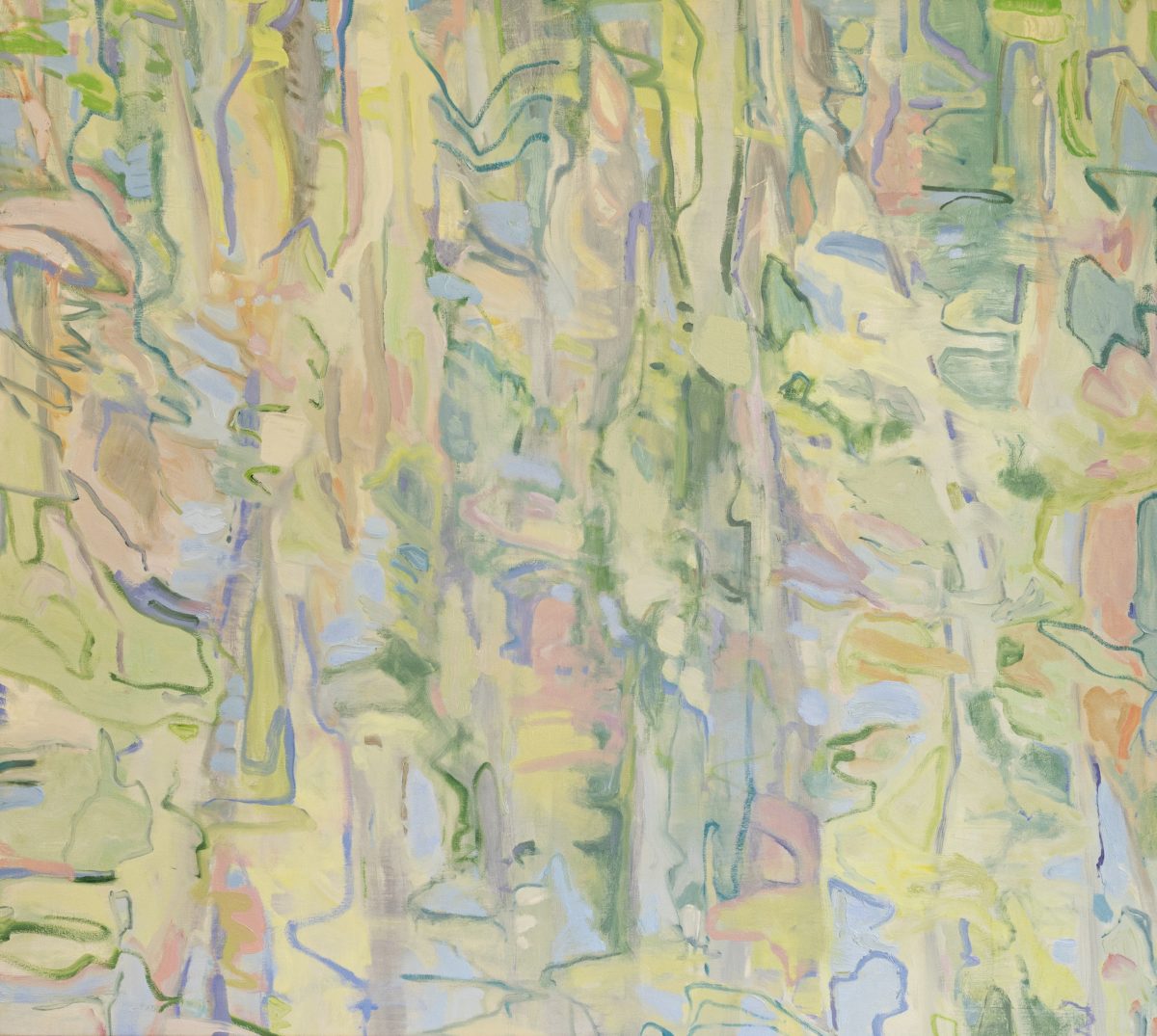Susan McAlister uses a number of approaches to landscape, from direct physical representations to more nebulous suggestions of place, to riffs on the basic forms and patterns that are the building blocks of the natural world. “My process is essentially the same whether I’m working representationally or abstractly,” says McAlister, whose work is the subject of “Canopy,” now on view at Les Yeux du Monde. “I’m finding form, I’m pushing color, I’m layering materials, I’m thinking about the relation of all of these elements together.”
The plein air tradition of sketching and painting out of doors is central to McAlister’s practice. “When I take my walks in nature,” she says, “I think about the shapes that are happening and the way the light moves through those shapes and how a vine travels up a tree and continues over your head. I’m considering all of this and what it’s like being engulfed by nature and how that makes my heart feel.”
While outside, McAlister also forages for natural found objects, which she uses as inspiration, sometimes incorporating them into her assemblages, thus rooting them in a specific time and place. “Faunus I,” for example, features a feather, petal, and bee. Originally inspired by a visit to the Matisse room at the National Gallery in Washington, D.C., McAlister took the concept of cut-outs and ran with it, adding three-dimensionality into the mix to produce her gorgeous explosions of layered cut paper.
Luminous vistas of the Blue Ridge cloaked in fuzzy haze are conjured up from a combination of McAlister’s observation and memory. “These wooded landscapes are about my childhood. I grew up where my playground was the uncut forest outside my door. That kind of tangled landscape, that’s orderly but also disorderly, is endlessly appealing to me.”
In “Near and Far,” the haze has been replaced with rain-washed crispness. McAlister uses extraordinary brushwork here, with bold expressive slashes, smears, and clumps of paint that describe the varied mountain terrain of woods, meadows, and streams.
“Meeting in the Woods” depicts the sort of tangled woodland that appeals to McAlister. In this rollicking work, the scene has shifted from the gently sloping hills of memory seen in “Wooded Way,” “The Engagement,” and “Evening,” to more rugged Montana. McAlister has amped up her brush work accordingly, with slashing strokes that describe the wind tossing the trees, and add points of visual interest to the work.
“Spring Shadows & the Forest Floor” seems to exist on the knife edge between abstraction and representation. McAlister has visually nailed the sense of wind, using large brushes to produce blurry contrails of paint along with quick daubs of green that suggest fluttering leaves.
The artist’s muted palette perfectly embodies the temporal and atmospheric conditions she wishes to convey. Light greens pinpoint the season as early spring. Dove gray represents the recesses of the forest interior. Elegant inky blotches describe roots, branches, and tree trunks, tiny flecks of cerulean blue and stark white brighten the sky with intense, pure pigment. In the upper left quadrant, the absence of green implies that we are at the edge of a clearing or body of water where the land opens up and the view of the sky is more expansive.
McAlister’s palette of sunny pastels is derived from Bonnard. It’s a challenging color scheme to make serious, particularly for an artist who states, “I don’t want to be cute, I don’t want to be sweet. I’m most pleased when my paintings read as bold and expressive.” So, she tempers her palette’s prettiness with the introduction of duller shades, gesture, and layering. You can see this in the rectilinear zones of “Edge of the Forest.”
“Come to the Woods” has a curious power that seems to build with each repeated viewing. The initial impression is of a work that is delicate and fragile, thanks to its pale colors and softly undulating shapes. But, the complex arrangement of pink, blue, green, and yellow and the interplay between painted surface and line, create interesting visual relationships. With its tessellated forms and passages that cascade down the picture plane, the work is really a deconstructed landscape.
Four paintings—“Vert,” “From the Open Window,” “Lost in the Forest,” and “Lush”—are hung together on the wall. McAlister did this to create a bigger expanse of painted surface. But the quartet’s juxtaposition, with two representational works and two abstract ones, hits at the crux of McAlister’s oeuvre, which is really about painting in and of itself, not one specific style. You see in these works, the ease with which the artist switches gears and her incredible facility, no matter how she’s painting. The “what” she’s painting remains a constant, however.
“Landscape is where my heart is,” she says. “It’s what I want to talk about.” As the works in the show reveal, McAlister uses various inventive means to “talk” about it, but one thing is clear, she is using a decidedly contemporary language to do so.
